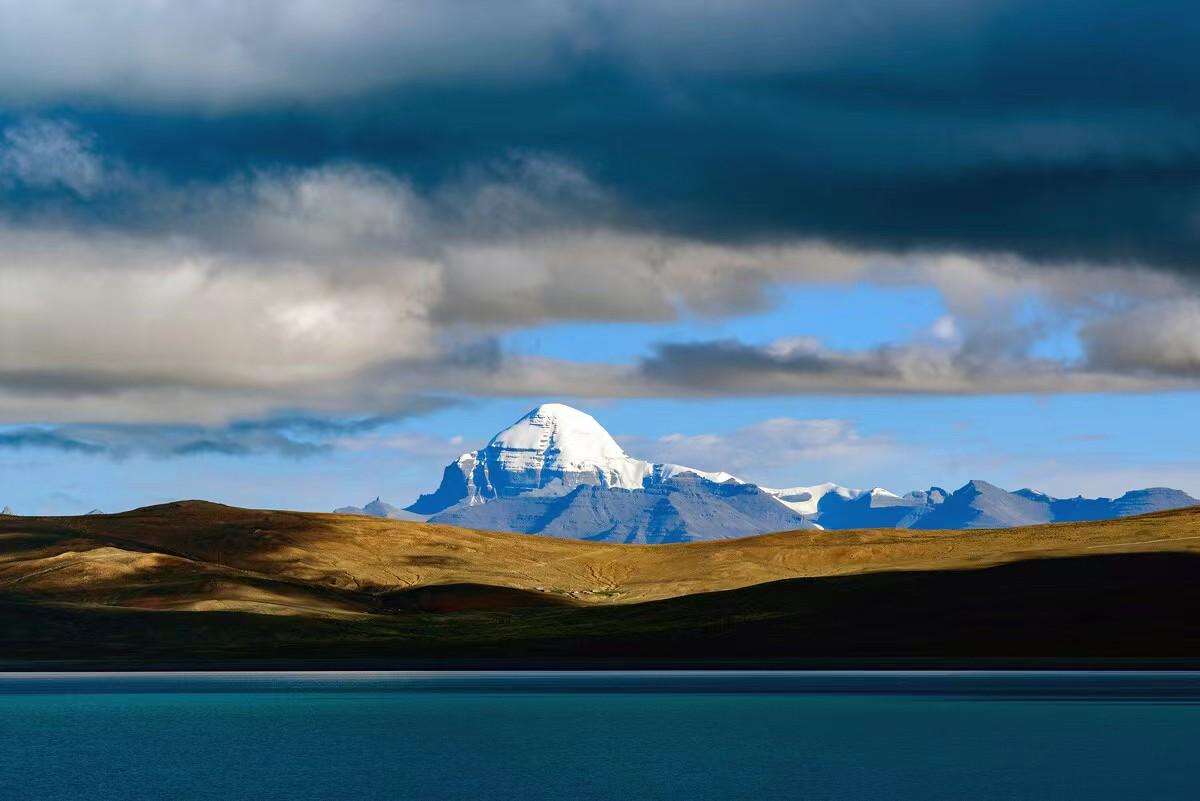Mount Kailash, revered by Hindu, Buddhist, Jain, and Bon followers, stands as a sacred pinnacle, beckoning pilgrims on the profound journey of Kailash Mansarovar Yatra. This article unfolds the intricate details and mystical allure of this pilgrimage, offering insights into the mythological significance, highlights of the Yatra, and practical considerations for a transformative experience.
Embarking on the Kailash Mansarovar Yatra is not merely a physical journey; it’s a spiritual odyssey that transcends religious boundaries. This sacred pilgrimage draws devotees and adventure seekers alike to the unparalleled beauty and spiritual aura of Mount Kailash.
Mythological Significance
Lord Shiva’s Abode
In Hindu tradition, Mount Kailash is hailed as the throne of Lord Shiva, where the deity resides in deep meditation with his consort Parvati. The awe-inspiring black granite form of Lord Shiva, known as the Shivalingam, adds to the divine ambiance.
Buddhist Meditation God
For Buddhists, Mount Kailash hosts Demchong, the tantric meditation god symbolizing supreme bliss. The pilgrimage holds deep significance as followers seek spiritual enlightenment through the circumambulation of this sacred mountain.
Jain Tirthankara’s Nirvana
Jains believe that Mount Kailash is the site where the first Tirthankara attained Nirvana. The spiritual energy of this place is thought to facilitate a connection with higher realms.
Bon Religion’s Spiritual Power
Preceding Buddhism in Tibet, the Bon religion regards Mount Kailash as the seat of all spiritual power. The entire region is seen as a mystical space, with the mountain itself representing a nine-story swastika.
Highlights of Mansarovar Yatra
Lake Mansarovar: A Divine Reservoir
Situated at the base of Mount Kailash, Lake Mansarovar is the highest freshwater lake globally, its clear blue waters holding sacred importance. The lake is believed to change colors, transforming into an emerald green hue towards the center, especially enchanting under the moonlight.
Mystic Temples Surrounding Kailash
The journey unfolds amidst five monasteries—Nyari, Drirapuk, Dzultripuk, Selung, and Gyangzha. Each monastery narrates unique stories through sculptures, statues, murals, and thangkas, offering a glimpse into the rich cultural tapestry.
Sacred Walk of Kailash: Outer Kora
The sacred outer kora, a 52km clockwise hike around Mount Kailash, is a pilgrimage trail laden with religious significance. This three-day trek from Darchen to Darche via Derapuk and Zutulpuk Monasteries, crossing the Dolmala Pass at 5630m, is a testament to the pilgrimage’s spiritual ardor.
Kailash Charan Sparsh: Touching the Divine
The Charan Sparsh Yatra, known as the touch of Kailash, is a day trip from Derapuk Monastery. Pilgrims traverse a glacier walk along the Gange river bank, aiming to touch the feet of Mount Kailash and receive blessings from Lord Shiva.
Inner Kora – Nandi Parikrama
This challenging sacred walk takes pilgrims to the highest point for the nearest view of Kailash. Starting from Darchen via Sealong Monastery to Saptarishi Cave and back to Darchen via Gyandrak Monastery, the inner kora offers a unique perspective, though participation is limited due to geographical challenges.
Rakshas Tal – The Poison Lake
Located on the west side of Lake Mansarovar, Rakshas Tal, also known as Lang-Tso, has mythological ties to Demon King Ravana. Pilgrims approach with reverence, and some Hindus perform spiritual pujas to cleanse negative energy.
Difficulty Level of Kailash Yatra
Altitude Challenges
The Yatra, with an average altitude of 5000m, presents physical challenges, making it a test of perseverance and spirit. Adequate preparation and a well-planned itinerary are essential for a successful journey.
Physical Preparedness
Before embarking on this spiritual journey, pilgrims must undergo a pre-departure health check. The demanding terrain and high altitudes require physical fitness and acclimatization.
Types of Walks and Their Difficulties
From the outer kora’s 52km clockwise hike to the challenging inner kora and the glacier walk to Kailash Charan Sparsh, each walk presents its unique difficulties. Pilgrims must be prepared for varying terrains and weather conditions.
Best Time for Kailash Mansarovar Yatra
Optimal Months
The Yatra is best undertaken between May and October when weather conditions are relatively favorable. Winter months pose challenges with freezing temperatures and snowfall, affecting high passes and local accommodations.
Weather Conditions During Different Seasons
While May to June and September to mid-October offer comfortable temperatures (0 to 33°C), nights can be chilly. Pilgrims should be prepared for rapid temperature drops and windy conditions.
Weather Conditions in Kailash
Temperature Variations
The months of May to June and September to mid-October provide the best weather conditions. Pilgrims can enjoy stunning views, deep blue skies, and fresh mountain air. However, nighttime temperatures can plummet.
Ideal Months for a Comfortable Journey
Choosing the right time ensures a more comfortable journey. Pilgrims can experience the beauty of Kailash Mansarovar without facing extreme weather conditions.
Most Auspicious Time to Visit Kailash
Saga Dawa Festival Significance
During the Saga Dawa Festival, local Tibetans believe that circumambulating Mount Kailash during the year of the Horse brings special blessings. The festival, coinciding with Lord Buddha Sakyamuni’s birthday, attracts pilgrims from all over Tibet.
Crowded Yet Spiritually Enriched
Despite the potential crowding during the festival, the energy and spiritual fervor make it an auspicious time to embark on the Kailash Mansarovar Yatra.
Packing Essentials
Layered Clothing for Varied Weather
Packing layered clothing ensures readiness for diverse weather conditions. From windproof fleece to thermal trousers, pilgrims must be equipped for temperature fluctuations.
Suitable Footwear for Trekking
Comfortable and sturdy trekking shoes are essential for the long walks and varying terrains encountered during the Yatra.
Necessary Accessories and Medical Supplies
Including trekking poles, a beanie, sunglasses, and sunscreen enhances the journey’s comfort. A basic first aid kit and altitude sickness medications are crucial for pilgrims’ well-being.
High-Calorie Snacks for Energy
Carrying high-energy snacks helps sustain pilgrims during the trek, providing the necessary fuel for the physical demands of the journey.
Travel Permit and Visa Requirements
China Group Visa and Tibet Travel Permit
Foreign travelers and yatries must obtain a valid China Group Visa and Tibet Travel Permit through authorized travel companies. The application process takes 3 to 4 working days.
Additional Regional Permits
Besides the group visa and Tibet permit, other regional permits and entry tickets are necessary for specific areas and sacred walks within Mount Kailash.
Budgeting and Finances
Planning for Expenses
Pilgrims need to plan their budget, considering the cost of the tour package, permits, travel, accommodation, and miscellaneous expenses.
Currency Considerations
Having the local currency and any required foreign currencies ensures smooth transactions and convenience during the Yatra.
Cultural Sensitivity
Respecting Local Customs
Familiarity with local customs and traditions is crucial for respectful engagement with the cultural richness of the region.
Responsible Travel Practices
Adopting responsible travel practices minimizes the environmental impact and ensures a harmonious coexistence with the local community.
Physical Fitness and Health
Pre-Departure Health Check
Undergoing a pre-departure health check ensures that pilgrims are physically fit to face the challenges of high altitudes and demanding terrains.
Acclimatization Strategies
Planning for acclimatization days allows pilgrims to adjust gradually to the high altitudes, reducing the risk of altitude sickness.
Document Preparation
Ensuring All Necessary Travel Documents
Pilgrims must ensure they have all necessary travel documents, including passports, permits, and any required certificates.
Emergency Contacts for Safety
Maintaining a list of emergency contacts, including local authorities and the tour operator, ensures preparedness for unforeseen circumstances.
Stay Informed
Regular Weather Updates
Staying informed about weather conditions in the region enables pilgrims to make informed decisions and be prepared for any changes.
Adherence to Local Regulations
Being aware of and adhering to local regulations and guidelines ensures a smooth and respectful journey through the sacred sites.
Conclusion
As pilgrims conclude their Kailash Mansarovar Yatra, they carry not just memories but a profound sense of spiritual and cultural richness. The journey, marked by devotion, challenges, and stunning landscapes, leaves an indelible mark on the hearts of those who tread the sacred path around Mount Kailash.



